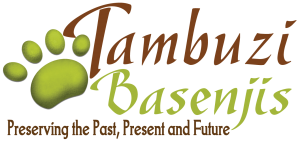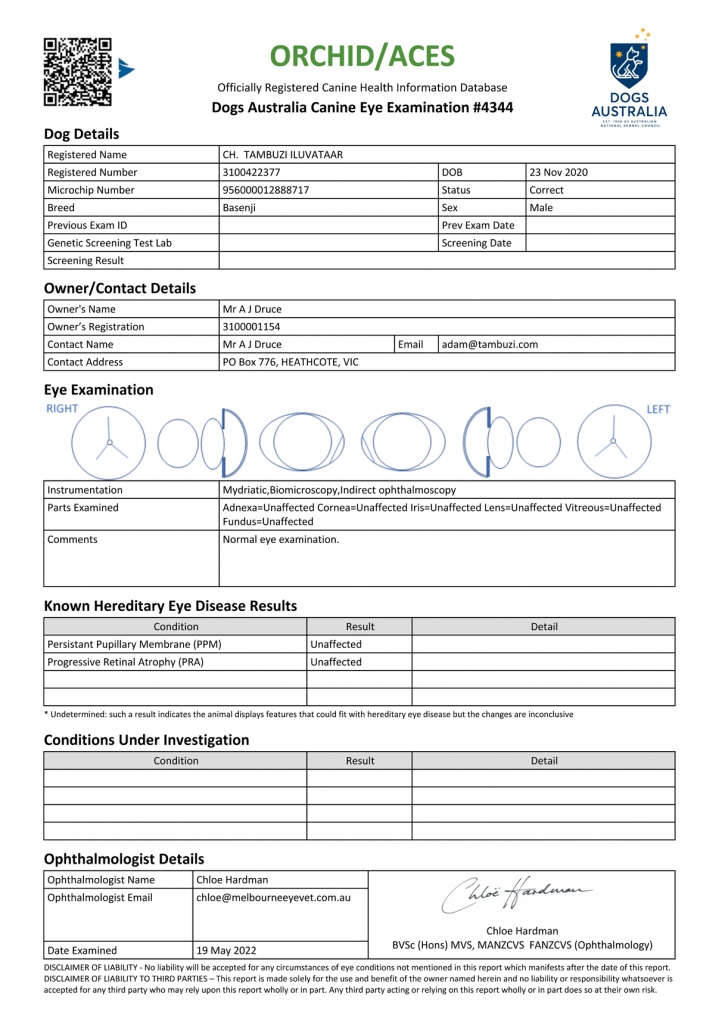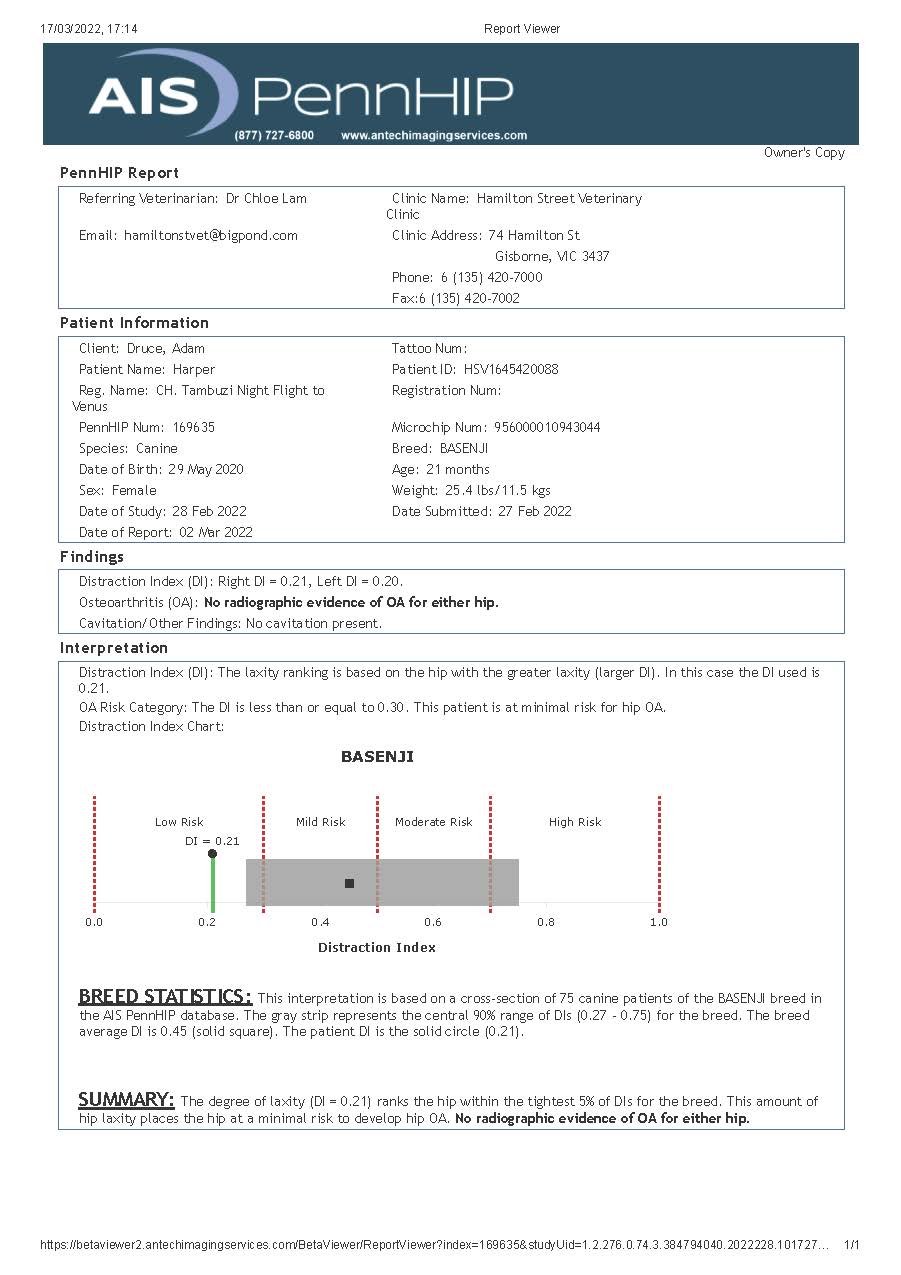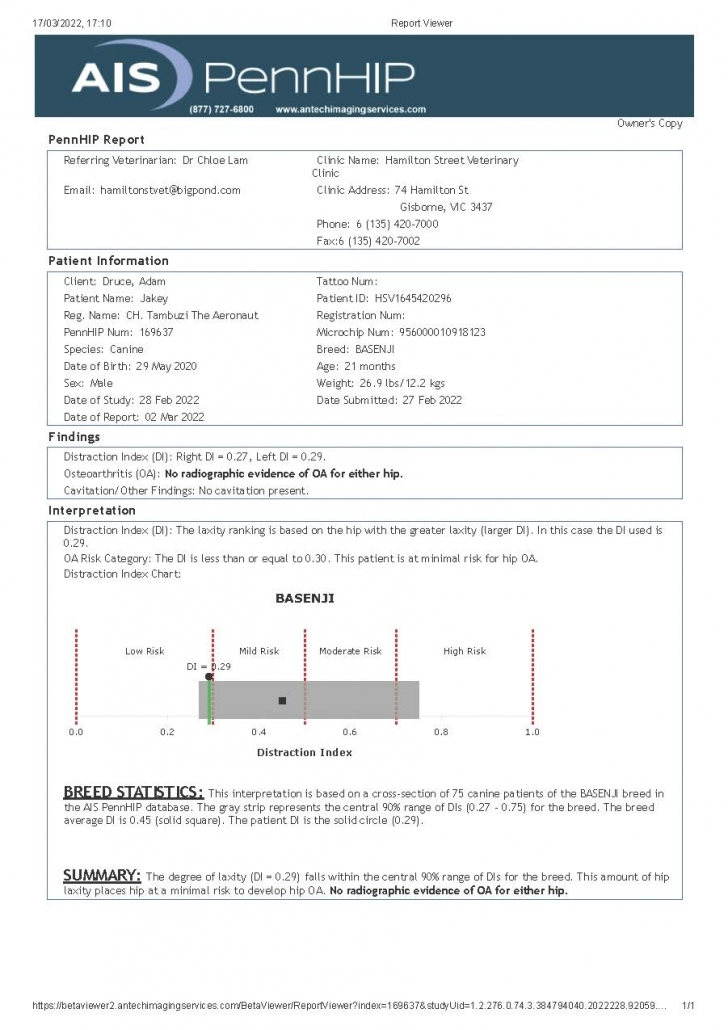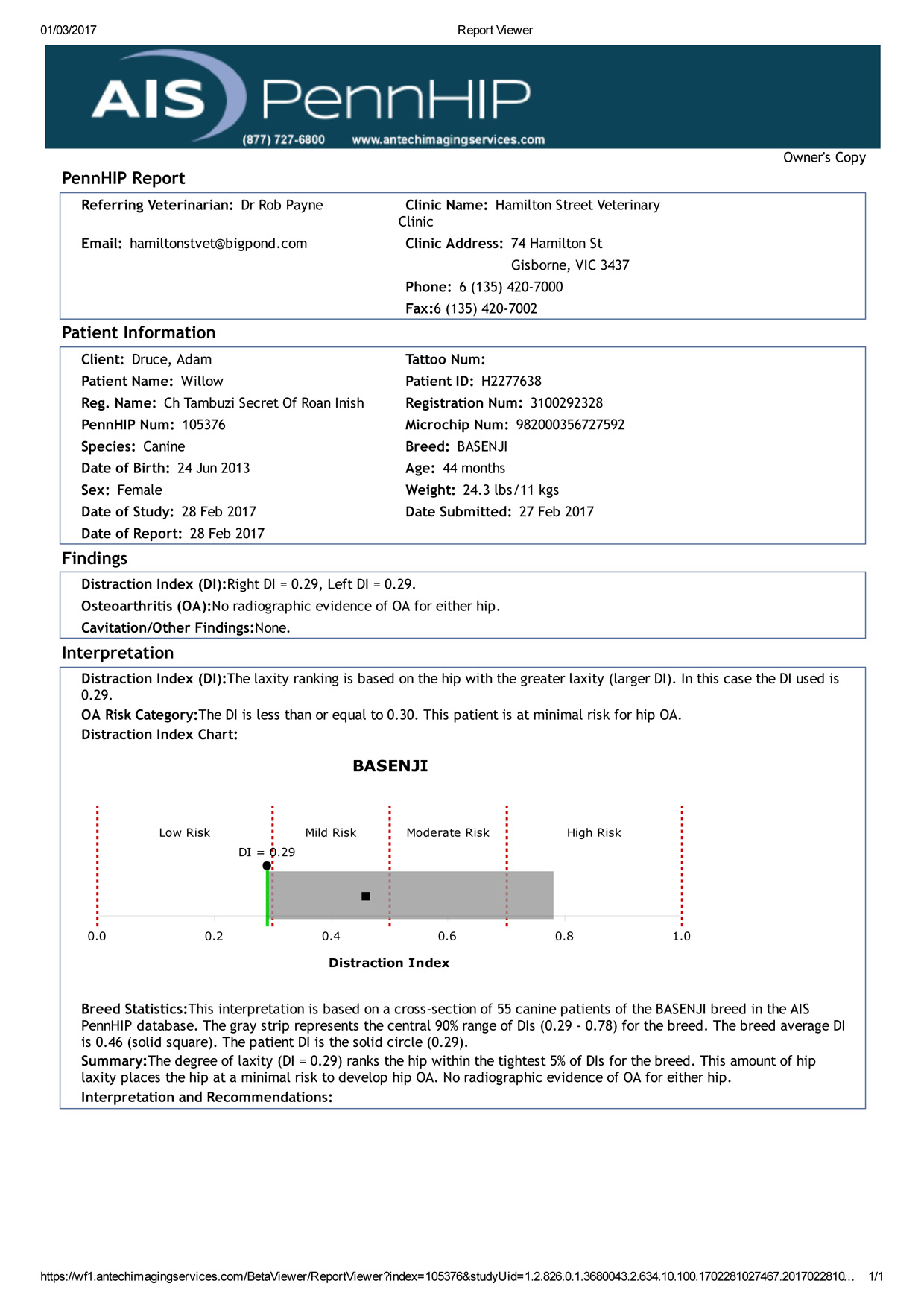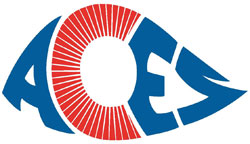Harper’s Hip Score
/in Health & Wellbeing, Latest News/by Adam DruceHarper's (Ch Tambuzi Night Flight To Venus) PennHip results were received in March. Yet another exceptional result. In fact Harper's hips score could be the lowest for a Basenji screened by the PenHip system which as a breeder is something to be proud of. Another one of my Basenjis ranked in the top 5% of the breed. Harper's score is below; Right Hip (Distraction Index) 0.21 and left 0.20, with no signes of OA in either hip. The breed ranges between 0.27 - 0.75 with an average 0.45.
Jakey’s Hip Score
/in Health & Wellbeing, Latest News/by Adam DruceJakey's (Ch Tambuzi The Aeronaut) PennHip results were received in March. He was screened at the same time as his litter sister Haroer. Very pelased with Jakey's hip score. The great result re enforces why such screening is so important. Jakey's score is just outside the tightest 5% for the breed, a percentage being reduced because of the low scores recently - many being my dogs scores. Jakey's score is below; Right Hip (Distraction Index) 0.27 and left 0.29, with no signes of OA in either hip. The breed ranges between 0.27 - 0.75 with an average 0.45.
Alfie’s Hip Score
/in Health & Wellbeing, Latest News/by Adam DruceAlfie's (Tambuzi The Aviator) PennHip results were received in March. He was screened at the same time as his litter sister Harper and litter brother Jakey. Very pelased with Alfis's hip scorew hich is well below the breed average. Right Hip (Distraction Index) 0.36 and left 0.32, with no signes of OA in either hip. The breed ranges between 0.27 - 0.75 with an average 0.45.
Willow’s Hip Score
/in Health & Wellbeing, Latest News/by Adam DruceWillow's (Ch Tambuzi Secret Of Roan Inish) PennHip evaluation report was received last week. Very pleased with her result. Both hips DI 0.29, with no evidence of OA in either hip. Willow's hips are ranked in the tightest 5% of the breed. The breed ranges from 0.29 (Willows score being the tightest) to 0.78.
The breed average DI is now to 0.46. This is disappointing as the average is higher some of the breeds one expects to have higher scores; for example, German Shepherd Dogs have an average score of 0.40, 0.6 lower than Basenjis!
I was amazed by the efficiency of the result - the X-rays were only taken one day and back the next from the US - well done PennHIP!
Eye Examinations
/in Health & Wellbeing, Latest News/by Adam DruceBoth Willow and Lyra had further eye examinations today. Their eyes have been screened as part of the Tambuzi Health Management Program. An ACES approved specialist conducted the eye examinations. I am very happy to report that both Lyra and Willow received certification that they both have 'normal' eyes. There was no sign of cataracts, PRA, coloboma, and no PPMs of any type. It is especially relevant that periodic eye screening is carried out in a breeding program. This is the second eye examination that Willow and Lyra have had completed.
Coconut Oil and Basenjis
/in Health & Wellbeing, Latest News/by Adam Druce I received the following warning from Dr Aine Seavers in relation to Coconut oil and Basenjis.
I received the following warning from Dr Aine Seavers in relation to Coconut oil and Basenjis.
Hi all
It has come to my attention from clients in general that the internet is currently pushing coconut oil as a treatment - topical and oral - for so many ailments.
This oil must not be fed to Basenjis of any age but especially the old and especially in cold weather when we are most at risk of the dogs throwing 'strokes' or CVAs.
Coconut oil has always been associated with hardening of the arteries and clots - something most dogs are not at risk of - but they can be and I suspect Basenjis do have this problem due to low normal thyroid and high normal cholesterol and haematocrit.
The reference below is from the 1970s which shows you how long this has been known but yet ignored by Dr Internet!
"Thrombosis in association with atherosclerosis induced by dietary perturbations in dogs R Mahley, AW Nelson, VJ Ferrans, DL Fry ABSTRACT:
The distribution, severity, and complications of diet-induced atherosclerosis in dogs can be altered by changing the source of fat in the diet. Thrombosis and thromboembolic disease associated with atherosclerosis occurred with diets containing beef tallow and lard of coconut oil but were absent in dogs fed cottonseed oil as a source of fat. Experimental animals with and without thrombosis are of value as models in elucidating the role of platelets and thrombostatic mechanisms in atherosclerosis."
Aine
Halle – ACES Eye Examination
/in Health & Wellbeing, Latest News/by Adam DruceHalle had a routine ACES eye examination today. Very pleased to report that Dr Robin Stanley's conclusion was that Halle's eyes are completely normal with no PPM of any kind. Halle was one of the first Australian Basenjis to be tested by the OFA for late on-set PRA (by DNA analysis) with a normal result. Halle will have one last ACES test when she is 10-12 years old.
Late-onset PRA
/in Health & Wellbeing, Latest News/by Adam Druce
Willow, Arthur and Raven have been DNA 'swabbed' to be tested for late-onset PRA. The DNA has been sent to Orivet for testing. The results are expected in the next couple of weeks. Based on the results of their parents, Willow, Arthur and Raven will have normal or carrier results.
For a full list of Team Tambuzi health results click here
Cystinuria in Basenjis
/in Health & Wellbeing, Latest News/by Adam DruceI read with interest the article written by Chris Maxka (SunDiata Basenjis, USA) recently published in the Victorian Basenji Breed Association's B-Mail about Cystinuria in Basenjis. The article explains that Cystinuria or Cystine bladder stones could be an emerging health concern in Basenjis. Cystinuria is potentially fatal and is found more commonly in Newfoundlands and Labrador Retrievers. To find out more about Cystinuria in Basenjis click on the link below.
What is Cystinuria?
 What is Cystinuria?
What is Cystinuria?
Cystinuria is a genetic defect. The defect affects the kidney tubules. This in turn affects the kidney's ability to filter cystine (an amino acid). The filtering process prevents this amino acid from going the urine. When this filtering action fails cystine passes into the urine. Over time crystals and/or stones can form. These stones can enter the urethra and cause an obstruction preventing the flow of urine. This form of blockage is more common in males due to their anatomy. Once there is a blockage the bladder is unable to empty. The bladder is likely to rupture which can be fatal.
Cystinuria is congenital in dogs where the issue is more common. Cystinuria is more common in Newfoundlands, Labradors, and Scottish Deerhounds. However, it can take many years for the crystals/stones to form in order that symptoms present themselves. Sometimes symptoms do not present themselves.
Unlike other bladder stones, cystine stones will not generally dissolve or breakdown with treatment. There are some drugs that can be given to try and break down the stones. These drugs are risky and are expensive. Drugs are not typically advised unless there are no other options. Generally, the stones are removed surgically.
In Basenjis, the symptoms may present at 17 months-11 years old. Cystinuria has been known in Basenjis for a long time. It is mentioned in the Complete Basenji by Elspet Ford. Although cases are rare this issue seems to be on the increase.
Mode of Inheritance
The mode of inheritance in Newfoundlands and Labradors is autosomal recessive. However, there is evidence pointing to the mode of inheritance being autosomal recessive with incomplete penetrance. That is a trigger is thought to be required for dogs predisposing of cystinuria to develop stones. The mode of inheritance in other breeds, although thought to be autosomal recessive, is not confirmed. The University of Pennsylvania are researching this issue in dogs and cats.
Symptoms
- obvious pain when attempting to urinate;
- poor urine flow;
- blood in the urine;
- a fowl rotten egg smell to the urine due to the presence of cystine crystals;
- dogs become despondent;
- walk with back arched due to pain in the kidney location; and/or
- cannot pass urine due to a blockage (this needs immediate veterinary treatment)
Treatment
In cases where a dog is diagnosed with this condition but is not presenting:
- crystals and/or stones;
- problems urinating; and/or
- signs of pain or discomfort;
a special diet may be advised. This diet is usually very low in protein which can help reduce the risk of stones forming. Some supplements can also be administered to reduce the risk of stones forming. In the case where stones have formed usually the only course is to have them surgically removed. Removal will prevent possible blockages in the urinary tract. When a blockage has occurred a process called retrograde-hydropulsion is employed. This process pushes the stone back into the bladder. Once the stone is in the bladder it can be removed.
Prognosis
Once diagnoses the prognosis is generally good. A change of diet is generally recommended. Further testing might be required to ensure that stones do not form. Once removed stones can re-form so continued observation is required.
New Information
It seems that most Basenji males block with this condition in the winter months. Basenji males have a season in the Autumn. Basenjis do not tend to drink as much coupled with the holding on (to mark) during the breeding season allows for the urine to be ultra-concentrated during the breeding season. The concentration of urine to any dog predisposed for this issue (has a genetic predisposition) allows for the formation of cystine crystal which then in turn form stones. It is thought that the formation of crystals and stone can take place within a few months hence blockages occur during the winter months. The fact that most Basenjis are house dogs and will hold-on as long as possible because they prefer not to go outside in the cold could also be a factor in the concentration of urine.
Prevention
Although there is no known prevention as such. Keeping male Basenjis hydrated before, during and after the breeding season may assist with preventing the issue in any that may be predisposed for it. Most Basenjis who have blocked were also fed a kibble diet. Feeding a raw based diet where water can be added to the food to increase the water consumption and therefore the hydration of the dog may also be of some benefit.
It is a good idea for owners to watch all males urinate at least once per day. If the flow is strong then the dog is fine. If the flow is not strong and the dog looks laboured then further observation will be required - remember that during the breeding season Basenjis will urinate a little bit a lot - it is not the amount that is important it is if it's a good stream or a dripping trickle that is important to observe. If the Basenji is generally clean, as most males are, and you notice that his bedding is damp or wet with urine in the morning - observe the Basenji urinating.
Should your Basenji try to urinate and no urine presents and the dog is obviously trying but is unable to go and is uncomfortable the dog may have blocked. If so this is a medical emergency. You need to get your Basenji to the vet immediately. If you do not act quickly this can be a fatal condition.
Research
Cystinuria is being researched at the University of Pennsylvania. Chris Maxka (SunDiata Basenjis, USA) is collating information about Basenjis with this issue. A database is being compiled to assist the researchers. The information being collected includes age and diet of likely patients. Individual information is kept confidential and is not passed to the researchers. Aggregate data is passed to the University of Pennsylvania researchers. If you have a Basenji that has been affected or has been diagnosed with Cystinuria your information may assist the research. If you wish to assist please contact Chris at her email.
Contact
PO Box 776, Heathcote, Vic 3523
Ph: +61 3 9018 9332
Fx: +61 3 5433 3636
Email: Adam Druce
Tambuzi Member of
Puppy Account Login
Pages
- About Basenjis
- About Me
- About Tambuzi
- Basenji Breeders Victoria Australia
- Basenji Puppies
- Basenji Puppies 2021
- Basenji puppies 2022
- Basenji Seniors
- Basenjis
- Basenjis Exported
- Basenjis Retired
- Blog
- Contact
- DNA Collector
- Faqs
- In Memory
- Judge
- Links
- Puppies 2023
- Questionnaire Received
- Questions to ask a breeder.
- Tambuzi Basenjis Health Results
- Tambuzi Roll of Honour
- Team Tambuzi Health
- Tambuzi Basenji Health Management Program
